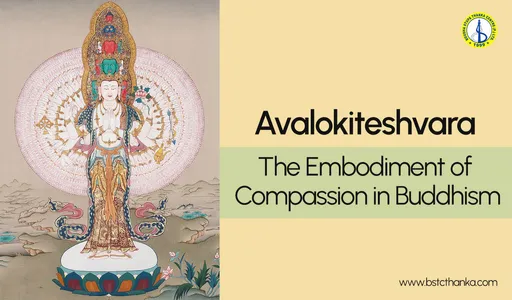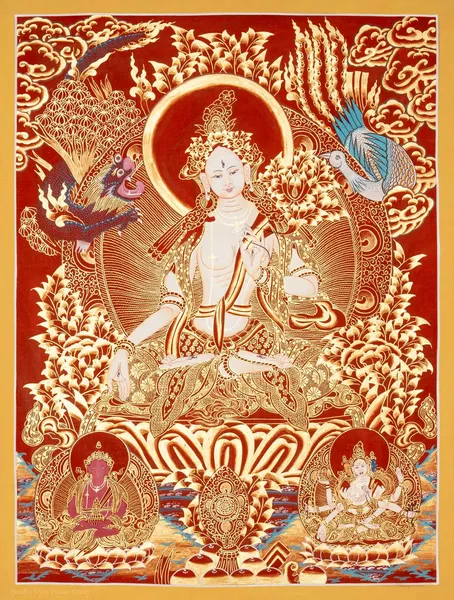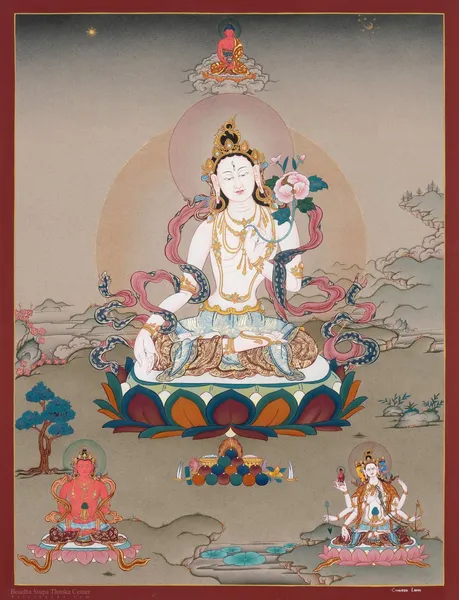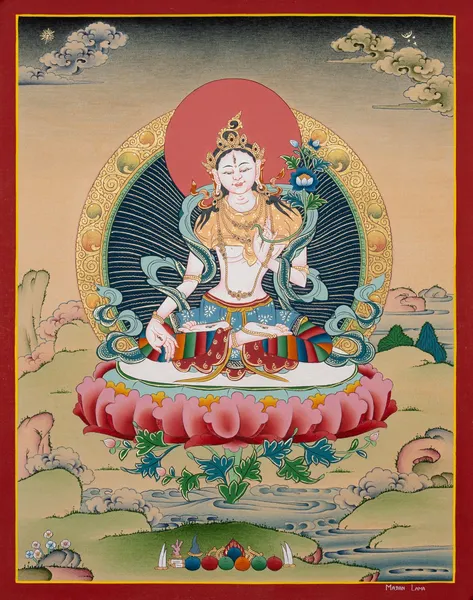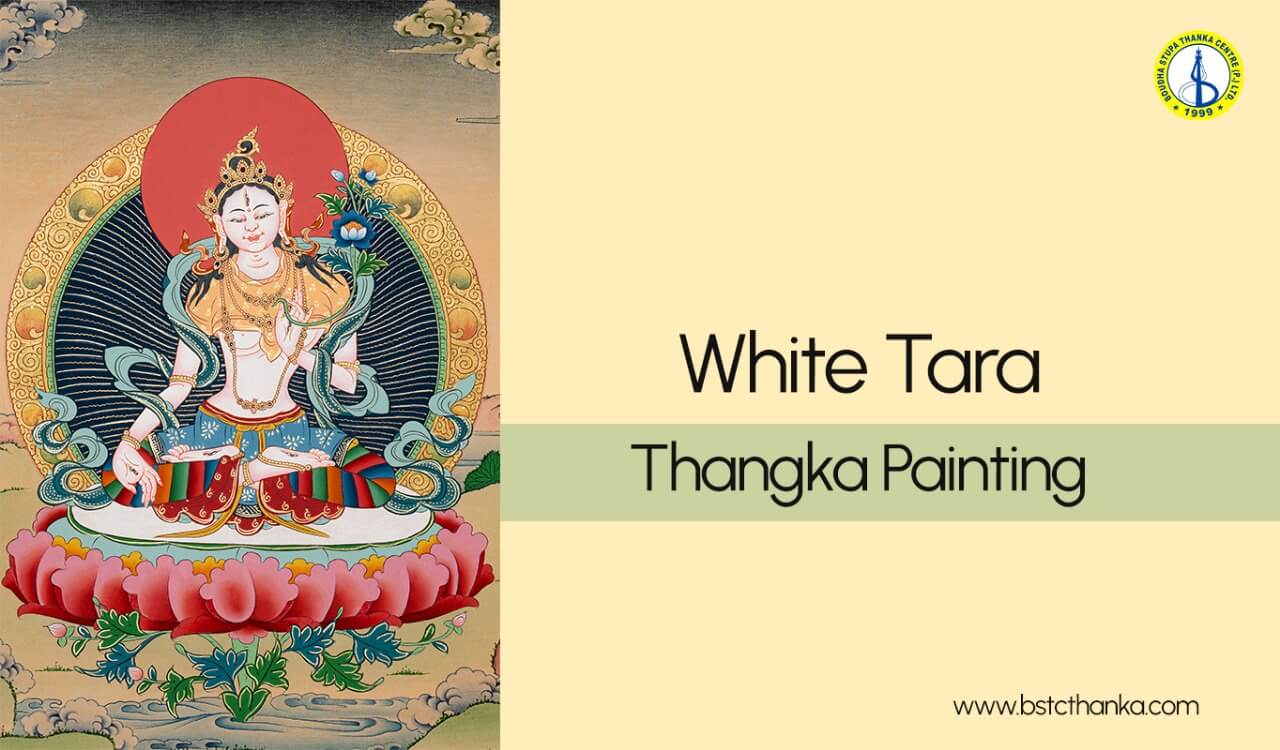
Who is White Tara in Buddhism?: History and Significance
In Buddhism, White Tara is a revered female Buddha who is associated with maternal compassion and healing. White Tara, also known as Sitatara, represents purity, healing, and long life. She is often depicted with a serene expression and seven eyes, symbolizing her vigilant awareness and boundless compassion. As a significant figure in Tibetan Buddhism, White Tara offers protection and guidance, helping practitioners overcome obstacles and cultivate spiritual growth.
White Tara is an important figure in Buddhism, representing the feminine side of spiritual growth. Her name, Sitatara, connects her to the purity of the moon and the light she brings. People meditate on White Tara Thangka to ask for her blessings, hoping for a long life, good health, and inner peace. Her energy helps guide them on their path to enlightenment.
History and Origin of White Tara the Buddhist Goddess
The origin of white Tara is traced back to early Buddhist traditions, where she is believed to have emerged from the tears of the compassionate bodhisattva Avalokiteshvara. This act symbolizes her deep compassion and desire to aid sentient beings. Over time, White Tara became a central figure in Tibetan Buddhism, where she is honored for her qualities of purity and healing.
Historically, White Tara's worship developed as a means to emphasize the importance of the feminine divine in Buddhist practice. Her imagery and practices were shaped by various Buddhist traditions, reflecting her role as a protector and guide. Devotees believe that her presence can bring about peace, longevity, and spiritual clarity. As such, White Tara has become a beloved figure for those seeking her nurturing support on their spiritual journey.
Also read about: Green Tara
Role and Symbolism of White Tara Deity
White Tara is a very important deity in Buddhism because she is seen as a savior who listens to the suffering of all beings. Her role is to protect and help people both in everyday life and on their spiritual path. By hearing the cries of those struggling in the cycle of life and death (saṃsāra), she offers guidance and relief from the difficulties they face. Her compassion and ability to save people from various dangers make her a cherished figure in spiritual practice.
Let's look at the key symbols associated with White Tara(Sita Tara):
1. The Seven Eyes
White Tara is often depicted with seven eyes. She has three eyes on her face (one on her forehead) and one on each palm and sole. The eye on White Tara's forehead represents her wisdom and the ability to see the true nature of reality. The many eyes of White Tara symbolize her insight and spiritual awareness, reflecting her deep understanding of the world beyond ordinary perception.
2. The Lotus FLower
The lotus flower is one of the main symbols associated with White Tara. Tara sits gracefully on a blooming lotus, representing her transcendence over worldly suffering and attachment.
3. The White Color
The white color symbolizes purity, wisdom, and compassion, reflecting White Tara's enlightened qualities. The color white is seen as a purifying and life-giving force.
4. Mudras
The hand gestures, or mudras, convey various meanings. White Tara's gesture of granting boons signifies her ability to fulfill the wishes of her devotees.
White Tara Thangka and Its Significance in Practitioners and Common People
People often buy White Tara thangkas for various spiritual purposes. These beautifully painted scrolls serve as focal points for meditation, helping practitioners visualize the deity and her qualities. During prayer, the thangka acts as a sacred object, enhancing the devotee's connection to White Tara's compassionate energy. Many also display these artworks in their homes or meditation spaces as a source of inspiration, reminding them of the virtues of compassion, wisdom, and protection. The symbols in her thangka, like the seven eyes and lotus flowers, remind them of her watchful care and purity. The thangka painting artwork is a cherished tool for connecting with deeper spiritual goals and finding comfort during their practices.
Also Read: Green Tara vs White Tara: An Insightful Comparison
Conclusion
White Tara is special in Buddhism as a compassionate and protective female Buddha. Her significance spans centuries, from her origins in ancient traditions to her current prominence in Tibetan Buddhism. White Tara's symbolism, depicted through her seven eyes, lotus flower, and serene white form, offers practitioners a powerful focus for meditation and spiritual growth. Her thangkas are more than just art; they are gateways to deeper understanding and connection with her energy. Whether for protection, longevity, or enlightenment, White Tara continues to inspire and guide countless devotees on their spiritual journeys.
For those seeking to integrate her divine presence into their spiritual practices, BSTC offers a curated collection of handmade Tara thangkas. Each thangka serves as a beautiful piece of art and a powerful tool for meditation and connection with White Tara’s compassionate energy.
FAQs
What is the significance of White Tara?
White Tara is significant in Buddhism for her deep compassion and healing power. She represents purity, long life, and protection, helping people find peace and overcome difficulties through her nurturing presence.
What are the benefits of White Tara's practice?
Practicing White Tara can bring many benefits, such as inner peace, better health, and a longer life. Her practice helps people feel protected and guided through challenges, fostering calm and spiritual growth.
What is the difference between White Tara and Green Tara?
White Tara and Green Tara are both important figures in Tibetan Buddhism but have different roles and qualities. White Tara focuses on longevity, healing, and protection from illness. She's often associated with extending life and wisdom.
Green Tara is known for her quick action in helping devotees overcome fears and dangers. She's seen as a more active protector against immediate threats.




